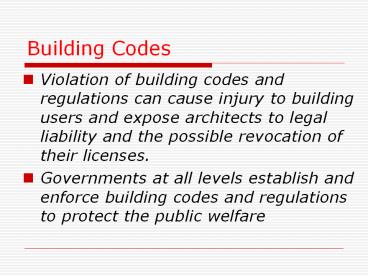Building Codes PowerPoint PPT Presentation
Title: Building Codes
1
Building Codes
- Violation of building codes and regulations can
cause injury to building users and expose
architects to legal liability and the possible
revocation of their licenses. - Governments at all levels establish and enforce
building codes and regulations to protect the
public welfare
2
(No Transcript)
3
Enforcement
- Building codes are most commonly enforced at the
local level. The central agency is usually the
building department that reviews drawings, issues
permits and periodically inspects the project for
conformance.
4
Jurisdiction
- A single project may be under the jurisdiction of
several agencies, health dept, water and sewer,
DOT, fire department. - Problems can arise because of simultaneous and
independent enforcement of codes, e.g. fire codes.
5
Penalties
- Stop work order to owner. Architect civil
liability, possible loss of license.
6
History of Building Codes
7
Code of Hammurabi
8
(No Transcript)
9
(No Transcript)
10
More recently September 11, 2001
11
Model Code Organizations
- Developed in response to the various, often
conflicting city codes written from the
insurance industry point-of view. 3 major
regional model codes
12
Model Code Organizations
- Building Officials and Code Administrators
International (BOCA) BOCA Code North Central
Northeast States, 1915 - International Conference of Building Officials
(ICBO) Uniform Building Code Western States,
1927 - Southern Building Code Congress (SCBBI) Standard
Building Code Southern States, 1940 - Adoption
- Est. 13,000 US building codes, adopted at the
local level
13
1990s began the revolution.
- the merging of 3 model codes into the
International Building Code (IBC) - Common format of all 3 codes established
- Allowed for direct comparison of similar design
situations
14
- Now we have a single national model code IBC,
maintained by a group comprised of
representatives of the 3 model-code agencies
International Code Congress (ICC) - In addition to the IBC we have the International
Residential Code (IRC) for detached 1 2 family
dwellings, townhouses less than 3 stories with
separate means of egress
15
(No Transcript)
16
Federal Requirements (not codes)
- Americans with Disabilities Act (ADA) of 1990
Federal civil rights legislation requiring that
buildings be made accessible to persons with
physical and certain defined mental disabilities.
This is a law not a code. Enforcement is the
law is through legal actions brought by
individuals or groups asserting violations of
their rights of access, as civil rights.
17
Federal Requirements (not codes)
- Occupational Safety and Health Act (OSHA) of
1970 Regulated building design and protects
workers (protection around openings, sanitation,
egress, lifts, contaminants, ventilation, noise
exposure, explosives, etc.
18
State Model Code Adoptions
- New Jersey adopted IBC in May 2003 revised as
the NJIBC
19
- Local Building Codes
- Many localities adopt the model-code documents
with little modification, except for the
administrative chapters that deal with the local
operations of the building department - Larger cities such as Los Angeles, New York,
Chicago San Francisco adopt more sweeping
changes to the model-codes or in some cases have
no basis at all in them. - How Do You Know What Code to Follow???
- Authorities Having Jurisdiction (AHJ) A
catch-all phrase for all planning, zoning, fire
and building officials having something to say
about building in a particular location. - The architect must determine exactly which codes
and standards are to be enforced and by which
agency get all revisions!!
20
NYC Building Code 2 volumes, currently changing
format to resemble IBC
21
Other Codes
- Most architectural work is concerned with the
building code and accessibility requirements,
however you need to be aware of the existence of
other codes for such work as electric, plumbing,
mechanical, fire sprinklers and alarms. - Among the specialized codes is the Life Safety
Code (NFPA-101) published by the National fire
Protection Association. This code serves as the
basis for the egress portions of the other model
codes.
22
Other Codes
- The NFPA also publishes NFPA-13 which governs the
installation of fire sprinklers and NFPA-70 which
is the National Electric Code (NEC). - It should be noted that NFPA did not join with
the other model-code organizations in the
formation of IBC they are completing the
development of NFPA 5000 to rival IBC
23
(No Transcript)
24
- Standard of Care
- Codes are legally and ethically considered to be
minimum criteria that must be met by the
architect the code is the level that a
practitioner must never go below. - Life Safety vs. Property Protection
- The basis for building codes development is to
safeguard the health, safety and welfare of the
public. - There is a strong component of property
protection in code requirements e.g. sprinklers
in occupied buildings and unoccupied buildings. - Security measures to protect the public may
become hazards e.g. window bars door hardware
that can trap inhabitants in an emergency.
25
(No Transcript)
26
(No Transcript)
27
Uniform Construction Code part of the New Jersey
Administrative Code NJ Rehabilitation Subcode
Regulates work on existing buildings
28
Types of Code Approaches Performance vs.
Prescriptive
- The current IBC, like the previous model codes,
is prescriptive in nature. It is developed to
mitigate concerns by creating a specific and
prescribed responses to problems that have been
identified. Architects identify the problem,
such as the width of a corridor, then they look
up the prescribed response in the applicable code
section.
29
- Performance codes define the problem and allow
the designer to devise the solution. Performance
codes give the designer more freedom to comply
with the stated goals. They also require the
designer to take on more responsibility for
knowing the consequences of their design actions.
30
(No Transcript)

